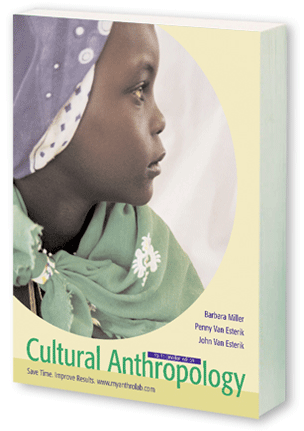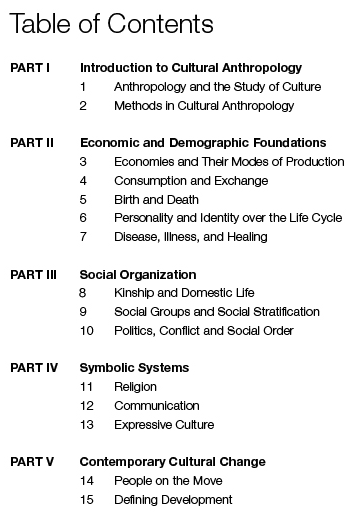

 |
|
How This Book Is Organized Cultural Anthropology pursues its goal of promoting learning about the world’s cultures in two ways, one that will be more familiar (the delivery of information) and another that may be unsettling and disturbing (asking questions about the information at hand that will make readers unsure of what they thought they knew). In the first place, readers will encounter abundant, up-to-date information about what is known about lifeways, cross-culturally: How do people in different parts of the world obtain food, conceive of their place in the universe, and deal with rapid cultural change? This substantive material of cultural anthropology begins with two chapters that establish a foundation for understanding what the discipline of anthropology in general is about, how cultural anthropology fits with it, and what the concept of culture means. In Part I of the book (“Introduction to Cultural Anthropology”), Chapter 1 (“Anthropology and the Study of Culture”) establishes the importance of the themes of social diversity and inequality that will accompany us throughout the book, especially class, race, ethnicity, gender, and age. Chapter 2 (“Methods in Cultural Anthropology”) takes us to the question of how one does research in cultural anthropology and how findings are analyzed and presented. Students will be able to link what they already know about general research concepts (for example, inductive versus deductive approaches, qualitative versus quantitative data) with what they learn here about how cultural anthropologists have used such concepts in their research and also come up with distinct approaches to data collection, analysis, and presentation. Following these two chapters, Part II, “Economic and Demographic Foundations,” moves into a consideration of cross-cultural ways of behaving and thinking in many domains from economics to religion. All aspects of life are interrelated and it is often difficult, in real life as well as in scholarly analysis, to separate them. Chapter 3 (“Economies and Their Modes of Production”) and Chapter 4 (“Consumption and Exchange”) appear at the beginning of the topical chapters as the foundation of culture. Reproduction, or “making people,” can be usefully paired with the topic of production, “making a living.” Therefore, treatment of reproduction is placed in Chapter 5, “Birth and Death,” which immediately follows the two chapters on economics. The book proceeds to the subject of the human life cycle in cross-cultural perspective (Chapter 6, “Personality and Identity over the Life Cycle”), presenting material from the exciting subfield of psychological anthropology. Chapter 6 connects with the introductory psychology courses that many students will have taken. The next chapter in this cluster about “making people” is Chapter 7, “Disease, Illness, and Healing.” A rare chapter in introductory cultural anthropology textbooks, this one will be particularly interesting to the many students who are considering careers in health-related fields. “Social Organization,” which includes chapters dealing with various aspects of “people in groups,” or social structures, begins with Chapter 8, “Kinship and Domestic Life.” This chapter incorporates up-to-date research that has enlivened the traditional core area of cultural anthropology. Although traditional categories and definitions are presented, the emphasis is on kinship in action, and on bringing kinship into a more relevant place in cultural anthropology. Chapter 9, “Social Groups and Social Stratification” widens the lens to examine social groups beyond the domestic situation, including clubs and cooperatives. Here, we also address how, in different societies, groups may be arranged hierarchically in relation to one another (for example, in India’s caste system). In Chapter 10, “Politics, Conflict, and Social Order,” we present cross-cultural material on the various forms of political organization and we include more than the usual amount of material on contemporary state-level societies. We also explore here the subfield of legal anthropology, an area of interest to pre-professional students considering careers in law and law enforcement. The chapters in Part IV, “Symbolic Systems,” explore the topics of ideology, belief systems, and values. All the previous chapters have related to belief systems and values in one way or another, but here, the focus becomes explicit, addressing three important subjects: Chapter 11, “Religion”; Chapter 12, “Communication,” including verbal language, nonverbal language, and the mass media; and Chapter 13, “Expressive Culture,” which includes the arts, the representation of culture in museums, play, and leisure. The final two chapters in Part V, “Contemporary Cultural Change,” bring together many of the topics addressed in Chapters 3–13 in their examination of two of the most important aspects of contemporary cultural change: migration and international development. Chapter 14, “People on the Move,” provides insights about categories of migrants and detailed information on the “new immigrants” in North America. Chapter 15, “People Defining Development,” shows how cultural anthropologists have contributed to making international development projects and processes more culturally appropriate and less harmful to local people, especially marginalized indigenous peoples and minorities. Both Chapters 14 and 15 highlight the “action” aspect of cultural anthropology and underline how it can be relevant to policy issues in the contemporary world. |
ISBN-13: 9780205702893
If you would like an exam copy of this text,
find your Pearson rep by clicking below:
| Copyright 2008 Pearson Education Canada,a division of Pearson Canada, Inc. All rights reserved. |